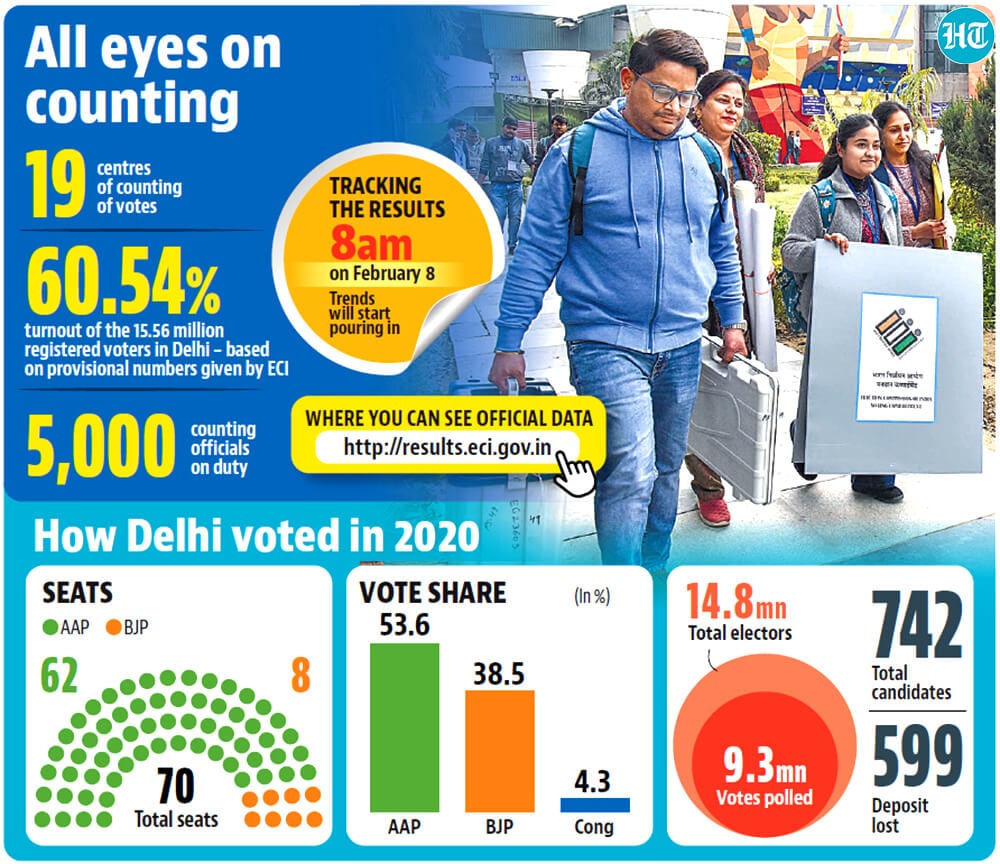Roughly 9.5 million votes cast at 13,766 polling booths to determine the next government of Delhi will be counted beginning at 8am on Saturday, bringing the curtain down on the first electoral contest of the year.

The votes will be counted at 19 counting centres across the national capital to determine the future of 698 candidates who were in the fray in what was the most closely fought assembly elections in years.
“We have made robust security arrangements [for counting day]. Only authorised personnel will be allowed inside the counting centres, where the use of mobile phones will be strictly prohibited,” special commissioner of police Devesh Chandra Srivastva said.
Around 5,000personnel will be on duty to ensure free-and-fair counting. The eve of the counting day was marked by rising political tensions in the Capital as all parties traded charges of irregularities.
Almost every exit poll has predicted that the Bharatiya Janata Party (BJP) is gaining in strength and might be headed for a victory after 27 years by ending the stranglehold of the Aam Aadmi Party (AAP) over the national capital. They were unanimous in terms of the larger direction of the outcome — they forecast that the BJP would improve dramatically on its 2020 showing and there would be big erosion in the AAP’s voter base.
In the 2020 assembly elections, the AAP won 62 seats and a vote share of 53.5%, the BJP won eight seats and 38.5% votes, and the Congress zero seats and 5% of the votes.
All but two exit polls predicted that the BJP will either clinch an outright majority in the assembly of 70 seats or come tantalisingly close to it. All but three exit polls suggested that the party, which last won the assembly elections in the Capital in 1993, will make a convincing comeback and trounce the AAP in many of the latter’s strongholds.
If these numbers hold on Saturday, it will mean that the BJP maintained the momentum of the 2024 general elections when it swept all seven parliamentary seats in the Capital, and of its historic victory in Maharashtra three months ago. It will also mean that after two consecutive defeats in assembly elections in Delhi, the BJP finally forged a winning formula to win over a city where voters regularly switch preferences between national and state elections.
“People want change and a corruption-free government. ‘AAPda’ is going, and the BJP is coming to power in Delhi. On February 8, our victory will be more spectacular then what exit polls have shown,” Delhi BJP chief Virendra Sachdeva said.
If these numbers tally on counting day, it will also hold bad news for the fledgling party that was born out of an anti-corruption cauldron in 2011 but has struggled to shake off mounting charges of corruption in recent years, especially against party chief and main vote catcher, former chief minister Arvind Kejriwal. It will also mean that the party that once fancied itself as a national player will only be left with control of Punjab amid erosion in its traditional vote banks and a crisis potentially confronting the party.
To be sure, exit polls have predicted a certain victory for the BJP, with margins varying. They predicted the AAP to secure any between 11 and 30 seats, with a prediction of 0 to 3 seats for the Congress.
“Under Kejriwal’s guidance, all candidates presented their ground reports, which indicated that AAP is set to win over 50 seats decisively with a close contest in seven-eight seats,” senior AAP leader Gopal Rai told reporters.
The assembly polls in Delhi were the first electoral battle in 2025 and saw a closely fought campaign that was clearly divided on lines of class and gender, and largely stayed away from communal issues.
Despite the modest size of the electorate, Delhi has always commanded outsized heft on the national political stage due to the prestige associated with ruling the Capital and the fact that its population reflects the diversity of broader national demographics. But over the past five years, unprecedented acrimony between the elected state government and the lieutenant governor (LG) derailed local governance and plunged the Capital into a morass of toxic air, crumbling infrastructure, rising crime and policy dysfunction.
The key to the outcome in Delhi will be demographics such as women, the poor, marginalised castes and middle-class colonies. Over the last 10 years, the AAP has maintained a stranglehold on the first three groups due to its governance delivery and welfare promises while the fourth is a loyal BJP voter base. This time, in fiercely fought elections, both major parties have made a play for these swing voters.
Among the issues that are likely to play on the voters’ minds, welfare, corruption, the condition of civic infrastructure and gang-related crimes. But these elections will also bookend a bruising five years for the Capital, which has been beset by communal strife, crime, infrastructure collapse and repeated clashes between two arms of the government that has hamstrung Delhi.


